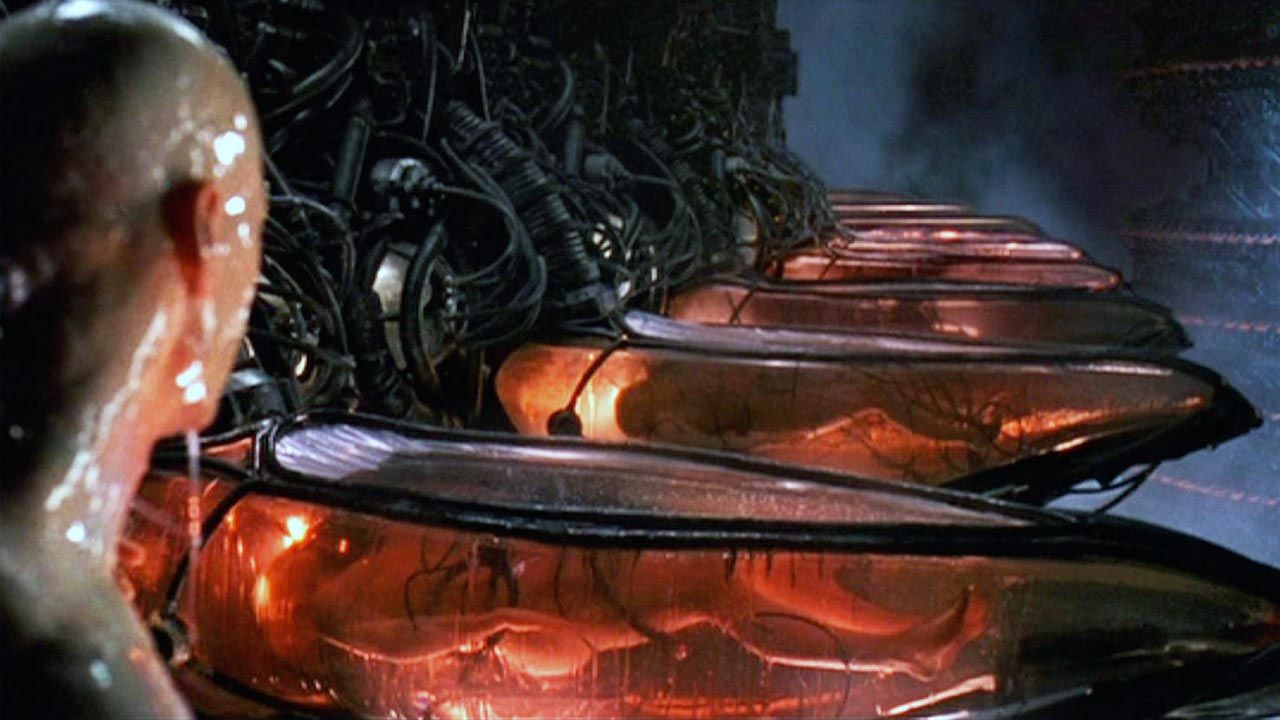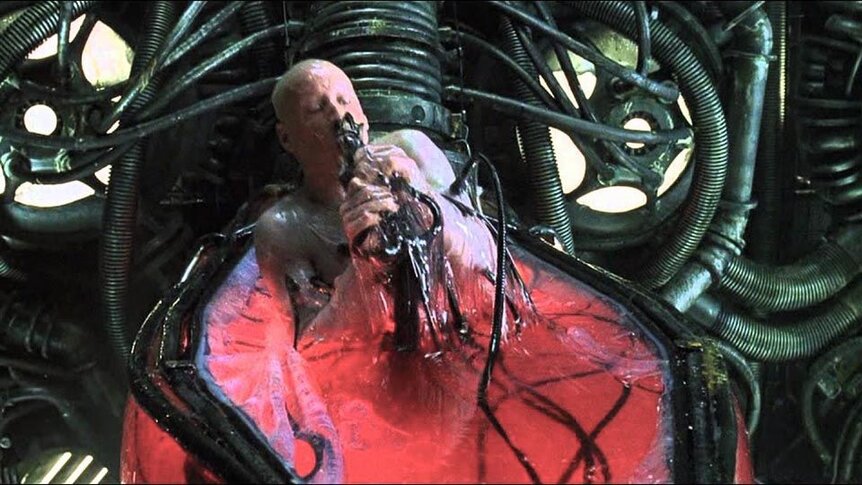Create a free profile to get unlimited access to exclusive videos, sweepstakes, and more!
Science Behind the Fiction: Humans as batteries, as in The Matrix... probably not gonna happen

It's been 20 years since the Wachowskis introduced us to the world of The Matrix, 20 years since we watched Neo take the red pill and follow the white rabbit beyond the digital frontier into a world of superpowers, sentient machines, and existential crisis.
Leaving the world he'd known behind, Neo discovers he is not really a human being living in the early 21st century. Instead, he is a battery, an energy source for the vast machine civilization ruling the world. The world he knows, the one where he has a job and acquaintances, is little more than a vast simulation meant to keep his mind occupied while his body cranks out juice for an army of robots and computer programs.
As a result of a global war, centuries before Neo was born, the sky was blackened and the sun blocked out in an attempt to starve the machines bent on human domination. Morpheus explains the terrible solution the machines resorted to in order to survive. "The human body generates more bioelectricity than a 120-volt battery and over 25,000 BTUs of body heat," he says.
To be fair, he does mention this harvesting of human energy is combined "with a form of fusion" to provide the machines with all the energy the would ever need. But the mention of fusion is almost a throwaway. The clear message here, accompanied by images of endless power plants, is humans have been enslaved as a power source for our synthetic masters. The Animatrix confirms this point, mentioning a "readily available power supply, the bioelectric thermal and kinetic energy of the human body."
"For the longest time, I wouldn't believe," Morpheus says. "And then I saw the fields with my own eyes." Yeah, well, seeing is believing, Morpheus. But I still have some questions.
Let's take a look at just how well a human body could act as a power supply and see how far this rabbit hole goes. Could human bodies, kept inert in creepy cyberpunk containers, act as a suitable power source?
FLESHY BATTERIES
The short answer is no. And you have thermodynamics to thank.
The first law of thermodynamics states, in simple terms, that energy cannot be created or destroyed. Whatever energy is put into a system (in this case a meaty flesh suit) can only be converted, either into work or heat.
In the film, humans are mostly inert, living out their lives in their heads. There isn't a lot of visible work being completed. But looks can be deceiving (somebody tell Morpheus), and even when a body is at rest, there is a whole lot going on.
Caloric expenditure is a tricky calculation. There are a lot of factors at play, including body weight and metabolism, but let's try anyway.
A 185-pound person burns an average of 56 calories per hour, at rest. Given that the humans locked inside the Matrix are essentially always at rest, living their lives in a continual dream state, a person of that weight would burn approximately 1,350 calories per day just lying in their pod. That's lost energy for the machines. And the actual caloric cost might be even higher. The brain accounts for roughly 20 percent of all energy used, despite adding up to only about 2 percent of total body mass. It turns out, thinking is hard work. And since the humans are living out full mental lives, there's no telling how much energy the brain is soaking up.
Because energy cannot be created or destroyed, those converted calories can't come out the other end for the machines to use. Any energy expended keeping their human cattle alive is a net deficit. Whatever kinetic or thermal energy they're getting off Neo's nude, bald, slimy person is negligible when compared to the energy needed to keep his heart pumping and his brain cracking code and pining over Trinity.
The second law of thermodynamics states that the sum of entropies between two or more interacting systems always increases, which is a fancy way of saying there's no such thing as a free lunch. When looking at the universe as a whole (the largest known interaction of systems), things move consistently toward disorder.
This can seem counter-intuitive, considering that we see examples of seemingly spontaneous order in our every day lives. One of the most common and profound examples is that of childbirth. A person (typically a woman) creates within them a complex, ordered entity out of disorder. But when you consider the whole of the involved systems — the food taken in, consumed, and converted to energy — the sum of entropies has increased; the amount of disorder outweighs the amount of order represented by the construction and birth of the child. Turns out babies are energy expensive, and that's in addition to the more than $200,000 it will cost to raise the kid. The Matrix is looking better and better.
In relation to energy production in Machine City, whatever energy is produced by the fields of pod people dreaming electric dreams beneath the blackened sky must necessarily be less than the energy expended. It isn't that no energy is being produced, just that it can't be enough to support the system. An array of human batteries is the energy equivalent of a Ponzi scheme. Someone might be getting rich, but it isn't you.
The third law of thermodynamics states that as a system moves toward absolute zero (-273.15° Celsius, or -459.7 Fahrenheit), randomness decreases and entropy approaches a constant. In other words, energy loss is decreased as things get colder.
The downside to this approach, as it relates to the machine's needs, is that reducing the temperature of their batteries to absolute zero would kill them, making the whole operation moot. It's sort of like exploding up a coppertop to make it more efficient. You might technically accomplish your goal, but at what cost?
All of this is incredibly inefficient. Even if the machines were able to use up all of the energy produced by a human brain, it would take them more than three days to charge an iPhone, and that would leave zero brain capacity for enjoying the fantasy land they created for us. We have no word on the charging time of a sentinel.
If the machines really wanted to use a biological power source, there are far better options than human bodies. Moreover, they could have built spires which reach above the scorched sky to get energy directly from the sun, or utilized nuclear energy without the need to farm people. The only real explanation for the vast fields of human bodies being maintained in stasis is that the machines wanted us alive for one reason or another.
Some have speculated they were using our brain capacity as crowd-sourced computing power. Others lean on Asimov's laws to suggest that, while the machines wanted us out of the way so they could go about their business, they felt an imperative to protect humanity on the whole. Either of these are better explanations than that of energy need.
In terms of power production, the machines would be better off letting all of humanity die off before burning the liquefied cheeseburgers they were planning to pump into our tubes and basking in the charbroiled glow. But I'm not about to tell them that.
Of course, maybe it's all just a fun cinematic experience meant to entertain and make us think about our choices and our place in the world. In that, the Wachowskis have succeeded. Twenty years on, we're still talking about the world they built and, by any measure, that is energy well spent.















